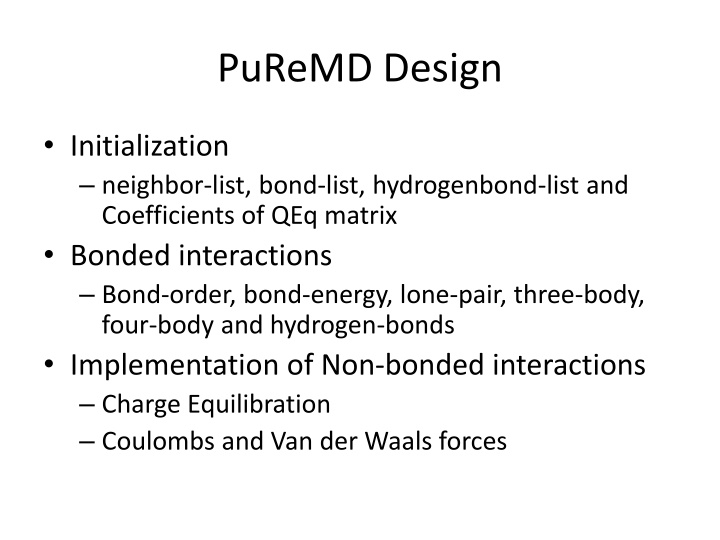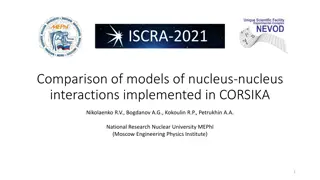PuReMD Design - Initialization, Interactions, and Experimental Results
PuReMD Design involves the initialization of neighbor lists, bond lists, hydrogen bond lists, and coefficients of QEq matrix for bonded interactions. It also implements non-bonded interactions such as charge equilibration, Coulomb's forces, and Van der Waals forces. The process includes the generation of neighbor lists and various data structures for efficient calculations of bonded and non-bonded interactions. Experimental results were obtained using specific hardware and CUDA environment for simulations with specific compiler options and precision settings.
Download Presentation

Please find below an Image/Link to download the presentation.
The content on the website is provided AS IS for your information and personal use only. It may not be sold, licensed, or shared on other websites without obtaining consent from the author.If you encounter any issues during the download, it is possible that the publisher has removed the file from their server.
You are allowed to download the files provided on this website for personal or commercial use, subject to the condition that they are used lawfully. All files are the property of their respective owners.
The content on the website is provided AS IS for your information and personal use only. It may not be sold, licensed, or shared on other websites without obtaining consent from the author.
E N D
Presentation Transcript
PuReMD Design Initialization neighbor-list, bond-list, hydrogenbond-list and Coefficients of QEq matrix Bonded interactions Bond-order, bond-energy, lone-pair, three-body, four-body and hydrogen-bonds Implementation of Non-bonded interactions Charge Equilibration Coulombs and Van der Waals forces
Neighbor-list generation 3D grid structure is built by dividing the simulation domain into small cells Atoms binned into cells Larger neighborhood cutoff, usually couple of hundreds of neighbors per atom
Neighbor-list generation Each cell with its neighboring cells and neighboring atoms Processing of neighbor list generation
Other data structures Iterating over the neighbor list to generate bond/hydrogen-bond/Qeq coefficients All the above lists are redundant on GPUs 3 Kernels one for each list Redundant traversal of neighbor list by kernels One kernel for generating all the list entries per atom pair
Bonded and Non-bonded interactions Bonded interactions are computed using one thread per atom Number of bonds per atom typically low (< 10) Bond-list iterated to compute force/energy terms Expensive three-body and four body interactions because of number of bonds involved (three-body list) Hydrogen-bonds use multiple threads per atom (hbonds per atom usually in 100 s)
Nonbonded interactions Charge Equilibration One warp (32 threads) per row SpMV, CSR Format GMRES implemented using CUBLAS library Van der Waals and Coulombs interactions Iterate over neighbor lists Multiple thread per atom kernel
Experimental Results Intel Xeon CPU E5606, 2.13 GHz, 24 GB RAM, Linux OS and Tesla C2705 GPU CUDA 5.0 Environment -funroll-loops -fstrict-aliasing -O3 Compiler options (same as serial implementation) Double precision arithmetic and NO fused multiply add (fmad) operations Time step: 0.1 fs and 10-10 tolerance, NVE ensemble
Memory footprint All the numbers are in MBs All data structures are redundant on GPU Three body interaction estimates the number of entries in the three-body list before executing the kernel because of which memory is allocated as needed with excessive over estimation as in the case of PuReMD C2075/6GB can handle as large as 50K system
GPU Overhead per interaction PuReMD-GPU uses additional memory to store temporary results and performs a final reduction for energy/force computation PuReMD-GPU uses additional kernels to compute reduction on lists to compute effective forces and energies for each interaction. These will NOT be incurred if atomic operations are used in these computations
Atomic vs. Redundant Memory Performance of kernels is severely impacted by using atomic operations on GPUs. 64 bit atomic operations are NOT supported on TESLA GPU, needs 2 32 bit operations. Results in serialization of competing threads. Additional memory provides dedicated memory to each thread. After the interaction kernel is completed, additional kernels are used to perform reductions to compute the final result.
Multiple thread Kernels performance All timings are in milliseconds Allocating multiple threads per atom yields tremendous speedups. Allocating more threads than needed, increases the scheduling overhead (increases the total number of blocks to be executed.
Accuracy Results Double precision arithmetic NO FMAD (fused multiply-add) operations Deviation of 4% after 100K time steps Million time steps of simulation executed
PG-PuReMD Multi-node, multi-gpu implementation Problem decomposition 3D Domain decomposition with wrap around links for periodic boundaries (Torus) Outer shell selection Full-shell, half-shell, midpoint-shell, neutral territory (zonal) methods etc PG-PuReMD uses full-shell rshell = max(3 x rbond, rhbond, rnonb)
Inter process communication 3D domain decomposition and full-shell as outer-shell for processes, we can use direct messaging or staged messaging Our experiments show that staged messaging is efficient as number of processors is increased Each process sends atoms in +x, -x, then +y, -y and finally in +z, -z dimensions
Experimental Results LBNL s GPU Clusters: 50 node GPU cluster interconnected with QDR Infinitiband switch GPU Node: 2 Intel 5530 2.4 GHz QPI Quadcore Nehalem processors (8 cores/node), 24 GB RAM and Tesla C2050 Fermi GPUs with 3GB global memory Single CPU : Intel Xeon E5606, 2.13 GHz and 24 GB RAM
Experimental Setup CUDA 5.0 development environment -arch=sm 20 -funroll-loops O3 compiler options GCC 4.6 compiler, MPICH2 openmpi Cuda object files are linked with openmpi to produce the final executable 10-6 Qeq tolerance, 0.25 fs time step and NVE ensemble























